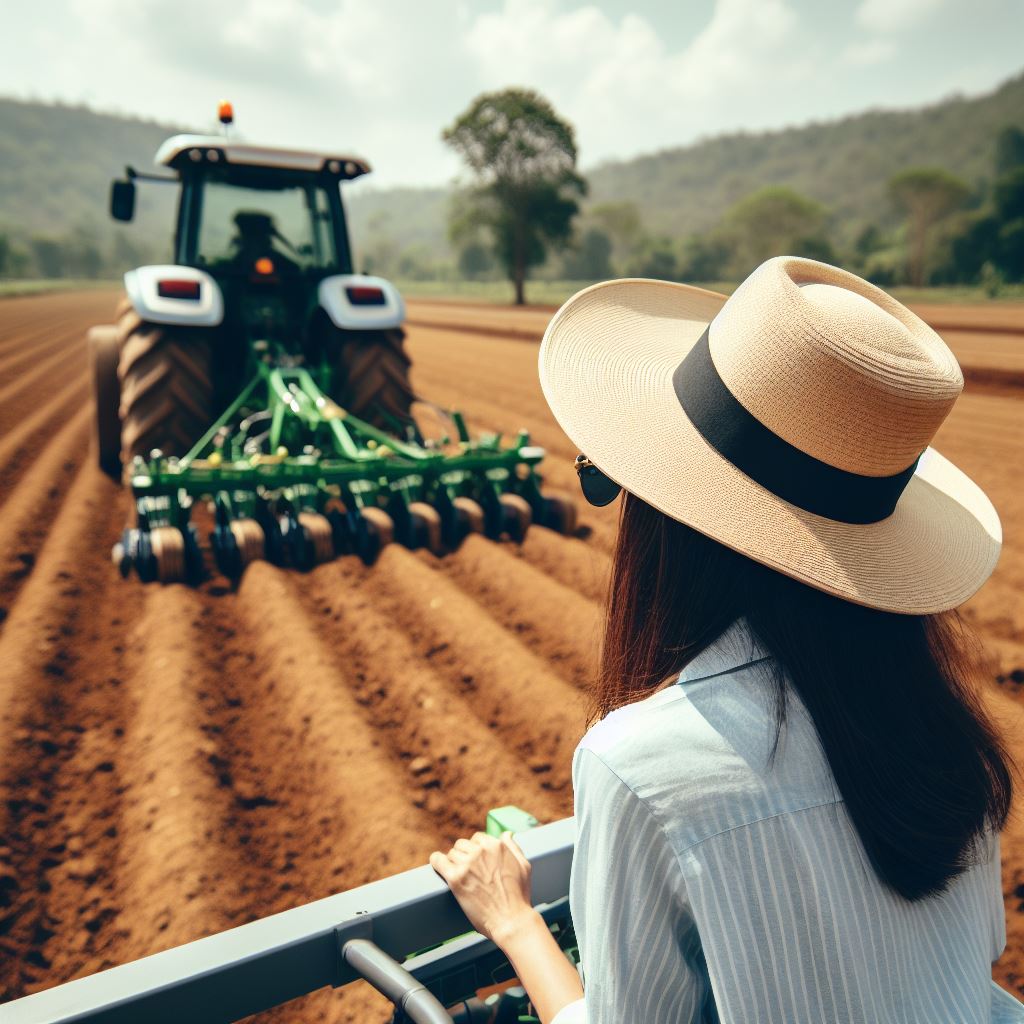Introduction
A. Definition and explanation of vertical farming
Vertical farming revolutionizes traditional agriculture by growing crops in a vertical manner, utilizing vertical space efficiently.
It maximizes production capacity and reduces the need for large land areas, making it suitable for urban environments.
B. The significance and benefits of urban agriculture
Urban agriculture plays a crucial role in addressing food security and sustainability challenges.
By growing food closer to consumers, it minimizes transportation distances and reduces carbon emissions.
Additionally, urban farming promotes community engagement, education, and the cultivation of fresh produce.
C. Thesis statement highlighting the rise of vertical farming
The rise of vertical farming aligns perfectly with the increasing demand for locally sourced, nutritious food in urban areas.
It addresses the limitations of traditional farming by providing year-round harvests, independent of factors like climate and soil quality.
Vertical farming also allows for the use of hydroponics and aeroponics, reducing the reliance on pesticides and herbicides.
Furthermore, vertical farms can be integrated into urban buildings, such as skyscrapers or warehouses, utilizing vacant spaces.
This not only enhances urban aesthetics but also provides job opportunities in the agriculture sector.
The close proximity of vertical farms to consumers helps create a sustainable food system, enhancing food security and reducing the pressure on rural agriculture.
Essentially, vertical farming has emerged as a solution to food production challenges in urban areas.
Its innovative techniques offer numerous benefits, including increased food supply, reduced environmental impact, and community involvement.
As the demand for urban agriculture rises, vertical farming will continue to shape the future of sustainable food production.
History of Urban Agriculture
A. Origins of urban agriculture
- Agricultural practices in ancient civilizations started in urban areas.
- Mesopotamians cultivated crops within city walls, creating the first urban farms.
- Egyptian city-dwellers had rooftop gardens to grow their own food.
- Chinese urban agriculture began with their innovative terrace farming techniques.
- In the Middle Ages, European monasteries had gardens to sustain the monks.
Urban agriculture has a rich history that dates back to ancient civilizations.
Transform Your Agribusiness
Unlock your farm's potential with expert advice tailored to your needs. Get actionable steps that drive real results.
Get StartedFrom the rooftop gardens of the Egyptians to the terrace farms of the Chinese, people have always found ways to cultivate crops in urban areas.
In the Renaissance era, royal kitchen gardens became popular in European capitals, while the Industrial Revolution led to a decline in urban agriculture due to increasing industrialization.
B. Evolution of urban agriculture practices over time
- Renaissance era saw the creation of royal kitchen gardens in European capitals.
- Urban agriculture declined during the Industrial Revolution due to industrialization.
- World Wars encouraged urban agriculture as a means to combat food shortages.
- The establishment of community gardens in the U.S. was a response to the Great Depression.
- In the 1960s, urban farming gained popularity through the concept of rooftop gardens.
During times of crisis such as the World Wars and the Great Depression, urban agriculture resurged as a means to combat food shortages.
Community gardens were established in the U.S., providing a sense of community and allowing people to grow their own food.
In the 1960s, rooftop gardens became popular as a form of urban farming.
C. The role of vertical farming in modern urban agriculture
- Vertical farming emerged as a response to limited arable land in urban areas.
- It is a method of cultivating crops in vertically-stacked layers or structures.
- Hydroponics, aeroponics, and aquaponics are commonly used techniques in vertical farms.
- Vertical farming allows year-round production regardless of weather conditions.
- It reduces transportation costs and carbon emissions associated with traditional farming.
- Urban areas benefit from increased access to fresh, locally-grown produce.
- The controlled environment in vertical farms minimizes the use of pesticides and herbicides.
- Vertical farming has the potential to address food security and sustainability issues worldwide.
However, the concept of vertical farming has revolutionized modern urban agriculture.
With limited arable land available in cities, vertical farming offers a solution to maximize crop production in a smaller footprint.
Vertical farms utilize innovative techniques such as hydroponics, aeroponics, and aquaponics to grow crops in stacked layers or structures.
One of the main advantages of vertical farming is the ability to achieve year-round production regardless of weather conditions.
This is particularly important in urban areas where weather fluctuations can greatly impact traditional farming.
Additionally, vertical farming reduces the need for long-distance transportation, mitigating carbon emissions and decreasing overall costs.
Vertical farming also benefits urban dwellers by increasing access to fresh, locally-grown produce.
With the controlled environment in vertical farms, the use of pesticides and herbicides can be minimized, leading to healthier and more sustainable food options.
The potential of vertical farming to address global food security and sustainability issues is immense.
In fact, the history of urban agriculture showcases the ingenuity of civilizations throughout time.
From its origins in ancient urban civilizations to the emergence of vertical farming, urban agriculture has evolved to meet the challenges of urbanization and food scarcity.
With the rise of vertical farming, the future of urban agriculture looks promising in providing sustainable food sources for urban populations around the world.
Read: Hydroponics: Soil-Free Farming Tech Trends
Advantages of Vertical Farming
Vertical farming offers numerous advantages, contributing to a sustainable and efficient agriculture system.
A. Efficient use of space
One of the significant benefits is the efficient use of space.
Unlike traditional farming methods that require extensive land area, vertical farming implements a vertical layout, stacking multiple layers of crops.
This unique approach optimizes space utilization, making it possible to cultivate a substantial quantity of crops within a smaller footprint.
B. Reduced water consumption
Moreover, vertical farms also address the issue of water scarcity.
By implementing hydroponics and aeroponics systems, these farms reduce water consumption significantly.
Showcase Your Farming Business
Publish your professional farming services profile on our blog for a one-time fee of $200 and reach a dedicated audience of farmers and agribusiness owners.
Publish Your ProfileThrough these innovative techniques, plants are grown without soil, only using nutrient-rich water solutions.
Compared to conventional agriculture, vertical farming allows up to 90% reduction in water usage, making it an environmentally friendly and sustainable option for food production.
C. Year-round crop production
Another advantage of vertical farming is its ability to enable year-round crop production.
Controlled indoor environments, such as vertical farms, can maintain optimal conditions for plant growth regardless of external factors.
By manipulating lighting, temperature, and humidity levels, farmers can create the ideal environment for crops.
This extended growing season ensures a constant supply of fresh produce even in regions with harsh climates or limited agricultural seasons.
D. Protection against pests and diseases
In addition, vertical farming offers enhanced protection against pests and diseases.
By growing crops indoors, farmers can limit the exposure to external threats such as insects, animals, and harmful plant diseases.
These controlled environments provide optimal conditions for crop growth, reducing the need for pesticides and other chemicals.
Consequently, vertical farms can produce healthier, chemical-free crops, ensuring food safety for consumers.
E. Decreased reliance on fossil fuels for transportation
Furthermore, vertical farming significantly reduces the reliance on fossil fuels for transportation.
Traditional agriculture often requires long-distance transportation of produce from rural areas to urban markets.
This transportation process contributes to greenhouse gas emissions and pollution.
However, vertical farms are typically located in urban areas, close to the consumers.
This proximity eliminates the need for long transport routes, reducing pollution and lowering the overall carbon footprint associated with food transportation.
In a nutshell, vertical farming brings numerous advantages to the agricultural industry.
The efficient use of space, reduced water consumption, year-round crop production, protection against pests and diseases, and decreased reliance on fossil fuels are all significant benefits.
By embracing vertical farming, we can establish a sustainable and resilient food production system, ensuring a brighter future for both the environment and humanity.
Read: Hydroponics: Soil-Free Farming Tech Trends
Vertical Farming Techniques and Technologies
A. Hydroponics: soilless cultivation
Hydroponics is a cultivation method that doesn’t use soil but instead relies on nutrient-rich water.
Using hydroponics, plants can receive all essential nutrients directly, resulting in faster growth and higher yields.
This technique is perfect for vertical farming as it allows plants to be grown in a controlled environment, regardless of geographical location.
B. Aeroponics: mist-based cultivation
Aeroponics takes hydroponics a step further, cultivating plants without any soil or water medium.
Instead, plant roots are suspended in the air and regularly sprayed with a fine mist of nutrient solution.
This mist provides all necessary elements for plant growth, allowing them to thrive in a nutrient-rich environment.
C. Aquaponics: integrated fish and plant cultivation
Aquaponics combines hydroponics with aquaculture, creating a sustainable ecosystem that benefits both plants and fish.
In this system, fish waste serves as a nutrient source for plants, while plants act as natural filters to purify the water for the fish.
It’s a mutually beneficial relationship where both components support each other’s growth and sustainability.
D. Artificial lighting and climate control systems
Vertical farms rely on artificial lighting systems to provide necessary light for plant growth.
LED lights are commonly used due to their energy efficiency and ability to emit specific light wavelengths.
Climate control systems ensure optimal temperature, humidity, and air circulation, mimicking ideal outdoor conditions for plant growth.
E. Automation and robotics in vertical farming operations
In modern vertical farming, automation and robotics play a significant role in optimizing efficiency and productivity.
Automated systems can monitor and control environmental factors, nutrient delivery, and harvesting processes.
Robotic arms are utilized for tasks such as planting, pruning, and harvesting, reducing labor requirements and increasing precision.
These technologies allow for precise and consistent plant care, resulting in higher crop yields and reduced production costs.
Vertical farming is revolutionizing agriculture by utilizing innovative techniques and technologies to maximize productivity and sustainability.
By implementing hydroponics, aeroponics, and aquaponics, plants can thrive without the need for traditional soil-based cultivation methods.
Artificial lighting and climate control systems ensure plants receive optimal conditions for growth, regardless of external factors.
Additionally, automation and robotics streamline operations, reducing labor requirements and increasing efficiency.
As urban populations continue to grow, vertical farming offers a viable solution to meet the increasing demand for fresh and locally-grown produce.
Showcase Your Farming Business
Publish your professional farming services profile on our blog for a one-time fee of $200 and reach a dedicated audience of farmers and agribusiness owners.
Publish Your ProfileWith further advancements in techniques and technologies, vertical farming has the potential to transform the future of agriculture.
Read: Hydroponics: Soil-Free Farming Tech Trends

Examples of Successful Vertical Farms
In the world of vertical farming, there are several successful examples that have emerged and garnered attention.
These pioneers have shown the potential and benefits of urban agriculture.
Let’s take a closer look at some of these successful vertical farms:
A. AeroFarms: Vertical Farming Pioneer in Newark, New Jersey
AeroFarms, based in Newark, New Jersey, is a leading vertical farming company that has made significant advancements in this field.
They have developed a proprietary indoor farming system that maximizes crop production.
By utilizing vertical stacking and LED lighting, AeroFarms is able to grow leafy greens and herbs in a controlled environment without the use of soil or pesticides.
This creates a more sustainable and efficient method of farming.
B. Gotham Greens: Rooftop Greenhouses across Several US Cities
Gotham Greens is another notable player in the vertical farming industry.
They specialize in rooftop greenhouse farming and operate in various cities across the United States.
By utilizing rooftops, Gotham Greens is able to utilize underutilized space and bring farming closer to urban centers.
Their innovative approach allows for year-round production of leafy greens, herbs, and other vegetables.
C. Sky Greens: Vertical Farm in Singapore
Singapore, known for its limited land resources, has embraced vertical farming as a solution to its food security challenges.
Sky Greens is one such vertical farm that has gained recognition in Singapore.
They have implemented a unique vertical farming system that utilizes rotating towers.
These towers maximize space utilization and facilitate the efficient growth of vegetables like bok choy and spinach.
D. Plantagon: Vertical Farming Project in Sweden
Plantagon, a vertical farming project based in Sweden, aims to revolutionize agriculture in urban environments.
They have developed a vertical greenhouse that combines traditional farming with modern technology.
This innovative approach allows for year-round production while minimizing the use of water, energy, and transportation.
Plantagon’s goal is to create self-sufficient city food systems that are sustainable and environmentally friendly.
E. Other Notable Vertical Farming Initiatives Worldwide
Beyond the aforementioned examples, there are several other noteworthy vertical farming initiatives worldwide.
Some of these include:
- Vertical Harvest in Jackson, Wyoming, which focuses on providing employment opportunities for individuals with disabilities while growing fresh produce.
- BrightFarms, with multiple locations across the United States, specializes in greenhouse-based vertical farming to supply local supermarkets with fresh and sustainable produce.
- Plenty, based in San Francisco, utilizes vertical hydroponic systems to grow a wide range of crops, including leafy greens, berries, and herbs.
All of these successful vertical farms demonstrate the potential of urban agriculture and its ability to address food security, environmental sustainability, and economic development in urban areas.
They serve as shining examples for the future of farming.
In general, vertical farming has seen significant growth and success worldwide.
Through the examples of companies like AeroFarms, Gotham Greens, Sky Greens, and Plantagon, we can witness the transformative power of urban agriculture.
With more innovative initiatives emerging, the future of vertical farming looks promising.
Uncover the Details: Revolutionary Tech Transforming the Future of Farming
Challenges and Limitations of Vertical Farming
This type of farming despite its many benefits, also faces several challenges and limitations that hinder its widespread adoption and scalability.
These challenges include:
A. High initial investment costs
- It requires significant upfront investment in infrastructure, technology, and systems.
- The cost of constructing vertical farms with specialized equipment and LED lighting can be exorbitant.
- Small-scale farmers, especially those in developing countries, may struggle to afford the high initial costs.
B. Energy consumption and environmental impact
- Vertical farms consume substantial amounts of energy, primarily due to artificial lighting and climate control systems.
- This high energy consumption contributes to increased greenhouse gas emissions.
- Efforts to reduce energy consumption and rely on renewable energy sources are crucial for the sustainability of vertical farming.
C. Limited crop diversity and scalability
- Vertical farming is most effective for growing leafy greens and herbs, limiting the range of crops that can be cultivated.
- Certain crops, such as trees or root vegetables, require more vertical space,
making them less suitable for this farming method. - Expanding vertical farming to include a wider variety of crops necessitates overcoming technical and logistical challenges.
D. Public perception and consumer acceptance
- The concept of growing food indoors may be met with skepticism or resistance from some consumers.
- Concerns about the taste, nutritional value, and safety of vertically farmed produce can negatively impact consumer acceptance.
- Effective communication and education about the benefits and rigorous quality standards can help address these concerns.
E. Regulatory and zoning issues in urban areas
- It often faces regulatory and zoning hurdles in urban areas.
- Existing regulations may not account for or support the unique infrastructure and technology requirements of vertical farms.
- Collaboration between policymakers, urban planners, and vertical farming advocates is necessary to develop appropriate regulations.
Overcoming these challenges and limitations is crucial for the growth and widespread adoption of this farming.
Addressing the high initial investment costs, reducing energy consumption, diversifying crop options, promoting consumer acceptance, and establishing supportive regulations are essential steps towards a sustainable and efficient urban agriculture system.
Discover More: Robotics in Agriculture: A 2024 Overview
Future Prospects of Vertical Farming
A. Potential contributions to food security and sustainability
Vertical farming has the potential to revolutionize food production by providing a sustainable solution to the increasing demand for food.
By utilizing unused urban spaces, vertical farms can produce large quantities of fresh and nutritious food.
This can help address issues of food security, providing a reliable source of food for urban populations.
Additionally, vertical farms can reduce the environmental impact of agriculture by minimizing the need for land, water, and pesticides.
B. Integration with smart cities and urban planning
Vertical farming aligns with the concept of smart cities, where technology is used to optimize urban living.
These farms can be integrated into urban landscapes, making food production more accessible and efficient.
Showcase Your Farming Business
Publish your professional farming services profile on our blog for a one-time fee of $200 and reach a dedicated audience of farmers and agribusiness owners.
Publish Your ProfileBy incorporating vertical farms into urban planning, cities can reduce their dependence on external food sources.
This integration can create a more resilient and sustainable urban environment.
C. Collaboration with traditional agriculture methods
Vertical farming should not be seen as a replacement for traditional agriculture methods but rather as a complementary approach.
Collaboration between vertical farms and traditional farms can lead to synergies that maximize food production.
Furthermore, vertical farms can provide support during periods of drought or extreme weather events that may affect traditional farms.
These collaborations can foster knowledge exchange and innovation within the agriculture sector.
D. Research and development for improved technologies
Continuous research and development are essential for the success and scalability of vertical farming.
Efforts should be focused on developing new technologies that enhance efficiency, productivity, and resource utilization.
Advancements in automation, artificial intelligence, and data analytics can revolutionize this farming systems.
These technological improvements will contribute to the long-term viability and profitability of this operations.
E. The role of vertical farming in space exploration and colonization
Vertical farming has the potential to be a crucial technology for future space exploration and colonization efforts.
By providing a sustainable source of food in space, vertical farms can enable long-duration space missions.
These farms can ensure the availability of fresh produce and reduce dependence on resupply from Earth.
Vertical farming also offers the possibility of establishing self-sustaining colonies on other planets.
This could be a stepping stone towards human colonization of space.
In essence, vertical farming holds tremendous promise for the future.
It can contribute to food security and sustainability, integrate with urban planning, collaborate with traditional agriculture, drive research and development, and even play a role in space exploration.
Continued innovation and collaboration across various sectors will be key to unlocking the full potential of vertical farming.
Read: Hydroponics: Soil-Free Farming Tech Trends
Conclusion
A. Recap of the rise and benefits of vertical farming
Vertical farming has emerged as an innovative solution to the challenges faced by traditional agriculture.
By utilizing vertical space and advanced technologies, urban farmers are able to grow crops efficiently and sustainably.
This method of farming offers numerous benefits.
Firstly, it allows for year-round production, reducing the dependency on seasonal variations.
Secondly, vertical farms consume significantly less water and land compared to traditional farming methods, making it more environmentally friendly.
B. The potential for vertical farming to revolutionize urban agriculture
Vertical farming holds immense potential to revolutionize urban agriculture.
With the global population steadily increasing, this practice can help meet the growing demand for food while reducing the pressure on rural land and resources.
By bringing agriculture closer to urban areas, vertical farming can provide fresh, nutritious produce to city dwellers.
This can address issues of food security, improve access to healthy food, and potentially reduce the carbon footprint associated with transportation.
C. Final thoughts and call to action for further exploration of the topic
The rise of vertical farming presents an exciting opportunity for the future of food production.
It is crucial to continue exploring and investing in this field to maximize its potential and overcome any limitations.
Researchers, entrepreneurs, and policymakers should collaborate to develop more efficient systems and optimize the technological aspects of the farming.
This will ensure its scalability and widespread adoption in urban areas around the world.
Moreover, individuals can contribute by supporting local initiatives and advocating for policies that promote sustainable agriculture.
Together, we can create a future where urban agriculture sustains our growing cities and nourishes their inhabitants.




